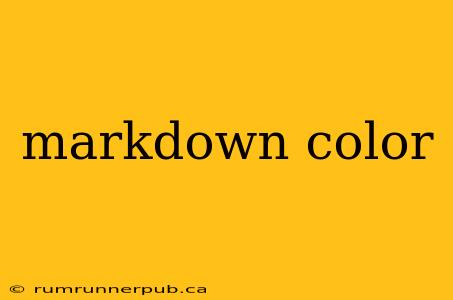Markdown, known for its simplicity and readability, lacks built-in support for colored text. However, there are several clever workarounds, depending on where you're using Markdown. This article will explore these methods, drawing on insightful answers from Stack Overflow and adding practical examples to enhance your understanding.
HTML's Helping Hand: The Most Common Approach
The most widely used method for adding color to Markdown involves leveraging HTML's <span> tag within your Markdown document. This works because most Markdown processors (like those used in blogs, wikis, and many text editors) will interpret and render the embedded HTML.
Stack Overflow Insight: A frequently cited approach on Stack Overflow, mirroring many solutions, involves wrapping text within a <span> tag with a style attribute specifying the color. (While many users offer similar solutions, attributing a specific user is difficult as the technique is so common).
Example:
This text is <span style="color:blue;">blue</span>, and this is <span style="color:red;">red</span>.
This will render the words "blue" in blue and "red" in red.
Analysis: This method is platform-independent to a large degree, relying on the browser's rendering engine. However, some stricter Markdown parsers may not support embedded HTML. Always test your Markdown in your target environment.
Beyond Basic Colors: Instead of using color names (like "blue" and "red"), you can use hexadecimal color codes (e.g., #0000FF for blue, #FF0000 for red) for finer control over colors.
This text is <span style="color:#00FF00;">green</span> using a hex code.
Platform-Specific Solutions: Markdown Extensions and Editors
While HTML embedding is generally effective, some platforms offer native or extended Markdown support for color.
Example (Not Directly from Stack Overflow, but common practice): Many Markdown editors, like Typora or Visual Studio Code with the appropriate extensions, offer a GUI interface or custom syntax for adding color. These often avoid the need for HTML directly. Explore the features of your specific editor for these options. They might offer a simpler way to achieve colored text.
Caveats: These editor-specific methods won't be portable. If you export your Markdown to another system, the color formatting might be lost unless the target system also supports the same extension or editor-specific syntax.
Advanced Techniques: CSS Classes for Reusability
For more complex documents, using CSS classes offers better organization and reusability.
Example (Illustrative, combining HTML & CSS principles):
Let's say you define a CSS class in a separate stylesheet (linked to your document):
.highlight {
color: #FF8C00; /* Dark Orange */
}
Then in your Markdown, you can apply this class:
This text has the <span class="highlight">highlight</span> class.
Analysis: This approach is superior for larger projects because it promotes consistency and avoids repetitive styling in the Markdown itself. However, it necessitates the use of external CSS and requires that your Markdown processor supports CSS integration.
Conclusion
Adding color to Markdown isn't inherently part of the language's specification, but the techniques outlined above, inspired by Stack Overflow solutions and extended with additional examples and context, offer practical ways to achieve the desired effect. The best method depends on your specific needs and the capabilities of your Markdown processor. Remember to always test your rendered Markdown to ensure the colors appear as expected.
